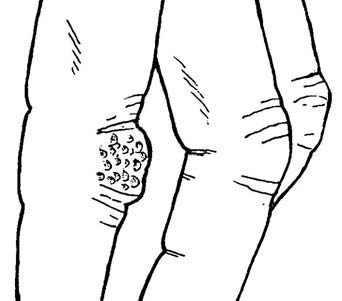Integumentary System
Lesson 3: Primary and Secondary Skin Lesions
3-3
3-3. DIFFERENT CONFIGURATIONS OF SKIN LESIONS
The process of diagnosing skin problems and diseases consists of several steps. First, the lesion(s) must be identified as early as possible. The shape of a single lesion should be noted. If there are several lesions, the arrangement of the lesions in relation to each other and their pattern of distribution should be observed. Diagnosis often depends on the shape, arrangement, and distribution of skin lesions.
a. Annular (Ring-Shaped). These ring-shaped lesions have a margin that is active and continues to grow. The center is usually clear. Ringworm is an example of such a lesion.
b. Imbricated (Overlapped). The edges of these skin lesions overlap.
c. Geographic (Resembling Continents and Islands). These skin lesions have highly irregular borders which resemble a geographic formation such as a continent. The most common example is hives.
d. Polycyclic (Multiple Rings). Skin lesions of this classification appear in groups of round circles.
e. Serpiginous (Creeping from Part to Part). This is the type of skin lesion which heals at one margin while spreading on the opposite side.
f. Target (Resembling a Wheal). A target lesion, also called an iris lesion, has two or three concentric circles. Erythema multiforme, an acute inflammatory skin disease, is an example of target lesions. See figure 3-1.
Figure 3-1. Erythema multiforme.
g. Verrucose (Wart-like). These lesions are small, usually hard lesions which are higher than the skin. A common wart, verruca vulgaris, is an example of this type of lesion. See figure 3-2.
Figure 3-2. Verruca vulgaris.



